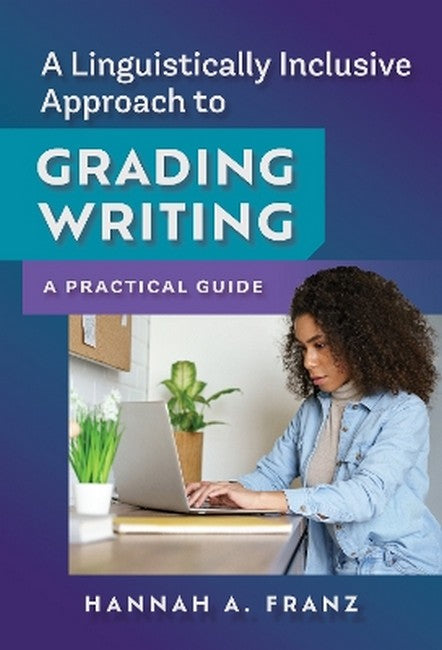Hannah A. Franz is the program associate for graduate advisement at the Jack Kent Cooke Foundation, and a coauthor of The Indispensable Guide to Undergraduate Research: Success in and Beyond College.
Request Academic Copy
Please copy the ISBN for submitting review copy form
Description
Contents Foreword Vershawn Ashanti Young ?vii Acknowledgments ?xiii 1. ?Introduction to a Linguistically Inclusive Approach to Grading Writing ?1 Language Variation and a Linguistically Inclusive Approach to Grading Writing ?2 The Time It Takes to Grade ?3 What Motivated Me to Write This Book ?4 Sociolinguistic Concepts That Inform This Book ?6 The Benefits of a Linguistically Inclusive Approach to Grading ?8 Is a Linguistically Inclusive Grading Approach for Me? ?10 Multicultural Education and Culturally Sustaining Pedagogy ?13 The Significance of Grades ?17 Historical Context of Grading Writing ?20 Study Backdrop ?22 Companion Resources ?22 Overview of the Book ?23 Self-Assess Your Practices ?24 2. ?Curriculum and Instruction for a Linguistically Inclusive Grading Approach ?25 Course Objectives in Support of Linguistically Inclusive Grading ?25 Instructor Motivations and Linguistically Inclusive Grading ?30 Instruction in Organization and Grammar ?34 Assignment Goals and Language Variation ?39 Audience ?41 Self-Assess Your Practices ?44 Linguistically Inclusive Practices ?45 3. ?Linguistically Inclusive Grading Processes ?46 Consider Grading Priorities and Distribution ?46 Align Grading Priorities With Instruction ?48 Read for Student Meaning ?51 Use and Explain Sociolinguistically Informed Grading Criteria ?52 Word Grading Criteria Positively ?56 Maximize Peer Feedback and Multiple Drafts ?57 Pose Questions Rather Than Penalties ?60 Self-Assess Your Practices ?60 Linguistically Inclusive Practices ?61 4. ?Linguistically Inclusive Commenting Strategies ?63 Reapportion Your Time ?64 Use Feedback as a Conversation ?65 Teach Through Specific Positive Comments ?66 Communicate High Expectations ?69 Highlight Your Subjectivity as a Reader and Acknowledge Multiple Audiences ?71 Ask Strategic Questions ?73 Contextualize Prescriptive Comments ?74 Rethink Labels ?77 Use Corrections Judiciously ?79 Self-Assess Your Practices ?81 Linguistically Inclusive Practices ?82 5. ?Organization and Word Choice ?84 Organization and Topic Relationships ?85 Respond to Organization and Topic Relationships in a Linguistically Inclusive Approach ?88 Pronoun Choice ?92 Respond to Pronoun Choice in a Linguistically Inclusive Approach ?94 Formal and Informal Word Choice ?96 Respond to Formal and Informal Word Choice in a Linguistically Inclusive Approach ?98 Self-Assess Your Practices ?100 Linguistically Inclusive Practices ?100 6. ?Grammar and Mechanics ?102 What Exactly Are Grammar and Mechanics? ?102 Grammar Patterns ?104 Respond to Grammar Patterns in a Linguistically Inclusive Approach ?108 Mechanical Features ?113 Self-Assess Your Practices ?116 Linguistically Inclusive Practices ?117 7. ?Putting It All Together ?119 A Linguistically Inclusive Approach to Grading: Summarized ?120 Application of Multicultural Education and Culturally Sustaining Pedagogy ?122 What Can a Linguistically Inclusive Grading Approach Look Like in Your Classroom? ?123 Conclusion ?131 References ?132 Index ?140 About the Author ?145

